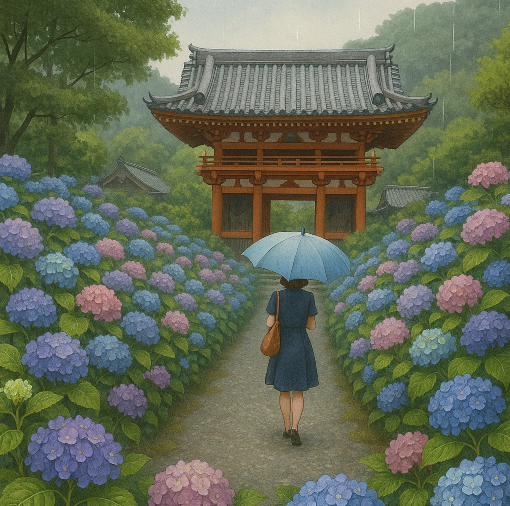
When it comes to hydrangea viewing in Japan, many travelers flock to Kamakura’s Meigetsu-in in the east. But in the west, there is a place equally, if not more, spectacular: Mimuroto-ji Temple in Uji, Kyoto. Known affectionately as “the Temple of Flowers,” Mimuroto-ji is Western Japan’s hydrangea capital, drawing visitors with its stunning garden and spiritual serenity each June.
A Sea of Hydrangeas Amidst Ancient Tranquility
Mimuroto-ji boasts over 10,000 hydrangea bushes of more than 50 varieties, spreading across its expansive temple grounds. From soft blue and lavender to vibrant pink and white, the flowers create a colorful mosaic against the backdrop of traditional temple buildings and lush green hills. Some visitors come seeking the famous heart-shaped hydrangea, believed to bring good luck when found—a fun and romantic twist to your stroll.
The hydrangea bloom typically reaches its peak between early and late June, perfectly aligned with Japan’s rainy season, or tsuyu. The gentle mist and light rain only enhance the ethereal beauty of the temple’s flower-covered slopes.
A Temple with Deep Roots
Founded over 1,200 years ago, Mimuroto-ji has long been a spiritual hub, known for its connections to Kannon, the goddess of mercy. While the temple is beloved year-round for its lotus and azalea blooms, the hydrangea season brings it into the spotlight, especially among photography lovers and nature enthusiasts.
Suggested Travel Route for Foreign Visitors
If you’re visiting Kyoto during the rainy season, here’s a recommended itinerary that includes this floral gem:
- Morning: Start in Kyoto City, visiting iconic sites like Fushimi Inari Shrine or Kiyomizu-dera Temple.
- Lunch: Enjoy traditional Kyoto cuisine at a kaiseki restaurant or simple udon shop.
- Afternoon: Take the train to Uji (just 30 minutes from Kyoto Station). Visit Byodo-in Temple (a UNESCO World Heritage Site) and enjoy matcha at a riverside teahouse.
- Late Afternoon: Walk or take a short taxi ride to Mimuroto-ji to admire the hydrangeas in the soft afternoon light.
- Evening: Return to Kyoto and wind down at a local onsen or enjoy a quiet stroll along the Kamogawa River.
Whether you’re a flower enthusiast, a photography lover, or simply seeking beauty and tranquility, Mimuroto-ji’s hydrangeas offer an unforgettable experience during Japan’s rainy season—an experience that rivals the best of Kamakura.
Mimuroto-ji official
https://www.mimurotoji.com/event/hydrangea.html
咲き誇る紫陽花:梅雨の季節に輝く京都の宝石、三室戸寺
日本で紫陽花を見ると言えば、多くの旅行者は東の鎌倉・明月院へ向かいます。しかし、西にはそれと同じくらい、いやそれ以上に壮観な場所があります――京都・宇治の三室戸寺です。「花の寺」として親しまれている三室戸寺は、西日本の紫陽花の中心地であり、毎年6月になると、その美しい庭園と精神的な静けさを求めて多くの人が訪れます。
古の静けさの中に広がる紫陽花の海
三室戸寺には、50種以上、約1万株の紫陽花が広大な境内一帯に植えられています。淡い青やラベンダーから、鮮やかなピンクや白まで、花々は色鮮やかなモザイク模様を作り出し、伝統的な寺院建築や緑豊かな山々の背景と相まって見事な景色となります。訪れる人々は、「見つけると幸運が訪れる」と言われるハート型の紫陽花を探すのも楽しみのひとつです――散策にロマンチックな要素を加えてくれます。
紫陽花は例年、6月初旬から下旬にかけて見ごろを迎えます。これはまさに日本の梅雨(つゆ)の季節と重なり、やわらかな霧や小雨が、花に包まれた境内の幻想的な美しさをさらに引き立ててくれます。
深い歴史を持つ寺院
1200年以上の歴史を持つ三室戸寺は、古くから観音信仰の地として人々の信仰を集めてきました。年間を通じて蓮やつつじなどの花でも知られていますが、紫陽花の季節には特に注目され、写真愛好家や自然を愛する人々でにぎわいます。
外国人旅行者へのおすすめ観光ルート
梅雨の時期に京都を訪れるなら、この花の名所を含む以下の旅程がおすすめです:
- 午前:京都市内からスタート。伏見稲荷大社や清水寺などの定番観光地を訪れます。
- 昼食:京都の伝統料理を楽しめる懐石料理店や、気軽なうどん屋で食事。
- 午後:京都駅から電車で約30分の宇治へ移動。平等院(世界遺産)を見学し、宇治川沿いの茶店で抹茶を楽しみます。
- 夕方:徒歩または短距離のタクシーで三室戸寺へ。午後のやわらかな光の中で紫陽花を鑑賞。
- 夜:京都市内へ戻り、温泉で疲れを癒すか、鴨川沿いの静かな散歩で1日を締めくくります。
花を愛する人も、写真を趣味とする人も、美しさと静けさを求める人も、三室戸寺の紫陽花は、梅雨の日本で忘れがたい体験を提供してくれます――それは、鎌倉に匹敵する魅力を持つ場所です。
三室戸寺公式サイト
https://www.mimurotoji.com/event/hydrangea.html
